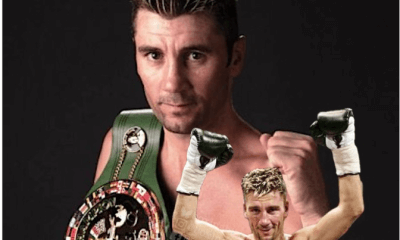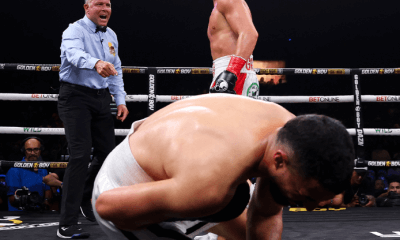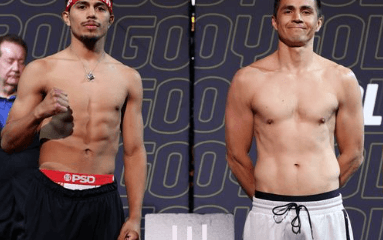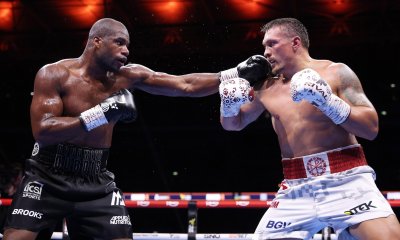Featured Articles
Schofield Outclasses Rhodes and Esparza Squeaks by Alaniz in San Antonio
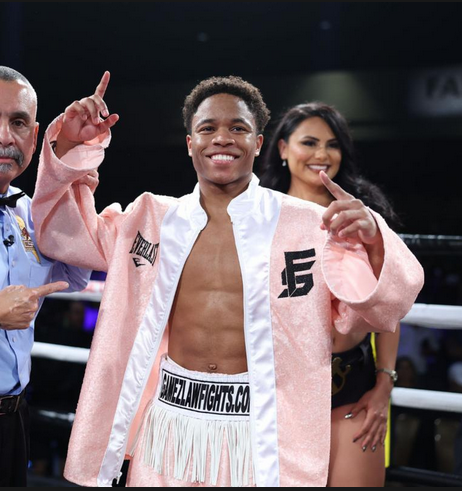
Fate stepped in and Floyd “Kid Austin” Schofield took advantage in displaying speed, power and patience in dominating rugged Haskell Rhodes by unanimous decision on Saturday in his main event debut.
Despite suffering a gruesome cut to the cheek, Schofield was flawless.
“I did what I had to do,” Schofield said.
Texas lightweight Schofield (15-0, 11 KOs) found out just days ago that he was bumped up to the main event and showed Rhodes (28-5-1, 13 KOs) and the boxing world his sterling talent at San Antonio, Texas.
He’s only 20 years old.
When scheduled welterweight contender Vergil Ortiz was forced out of the main event due to medical complications, Golden Boy Promotions confidently inserted the young Texas lightweight prospect. Schofield eagerly accepted the challenge.
Rhodes, a veteran from Las Vegas who fought a former world champion, proved to be the perfect partner with only one knockout loss in 35 fights.
Schofield used a strong left jab to keep Rhodes from attacking inside. For the first half of the fight Rhodes kept setting traps to unload overhand rights. But the young Texas fighter never allowed many openings.
Schofield used stiff jabs and feints to keep Rhodes from rushing in. And at times he blasted the body to keep his shorter foe at a distance.
In the seventh round Rhodes decided to use his background in MMA and tackled Schofield twice to bring the younger fighter down. It seemed to ignite the Texan and he got up in total attack mode. A volley of blows capped by a left uppercut floored Rhodes who got up at the count of nine. The fight continued and Schofield blasted away with another volley and down went Rhodes again for a count of nine.
“I seen he was dipping down on the same side,” Schofield said.
Rhodes survived.
“He can take a hell of a punch,” Schofield said.
Schofield opened the eighth frame hungry for a knockout and chased Rhodes around the ring. When the two fought inside Schofield connected with a sneak left hook to the liver and after a few seconds Rhodes sunk to his knee. He beat the count again.
In the ninth round Schofield stepped up his attack looking to end the fight. Rhodes butted Schofield and followed with a right that missed. But his head connected and down went Schofield with a nasty gash on his left cheek. The ringside physician was called and he allowed the fight to continue. Schofield celebrated.
“He did that on purpose,” said Schofield about the head butt by Rhodes. “I kind of felt it when I got up.”
In the final round the undefeated Texan used his jabs and left hooks to keep Rhodes at a distance. In the final 10 seconds he vaulted to attack mode and exchanged with the rough Rhodes until the final bell.
After 10 rounds all three judges scored it 100-87 for Schofield.
Marlen Esparza Unifies
Once again Marlen Esparza benefitted somewhat from home state judging and defeated rival champion Gabriela Alaniz to unify the flyweight titles by majority decision.
Esparza is living a charmed life.
Esparza (14-1, 1 KO) banked on accuracy to out-duel Argentina’s Alaniz (14-1, 6 KOs) in front of a large Texas crowd.
One thing is certain, Esparza can take a punch.
Though Alaniz fired countless blows like a buzzsaw it was Esparza who was far more accurate. In the opening round Esparza ran across and connected with a lead right.
The Argentine fighter was known for aggressive volume punching and after a couple of rounds began to adapt to Esparza’s style.
Esparza could not miss with the right cross and every time Alaniz tried to counter the Olympian slipped and moved out of danger.
Around the fourth round Alaniz began to find the range for her battery of blows. And though Esparza was connecting with single punches the sheer volume of blows from the Argentine fighter could not be ignored.
Combinations began to connect for Alaniz and Esparza seemed willing to trade blows. But it also allowed the fighter known as “la Chucky” to gain confidence.
Alaniz scored heavily in the seventh and eighth rounds with volume punches as Esparza seemed to tire. In the ninth round Esparza opened with a lead right and seemed to regain control. It kept Alaniz slightly off her rhythm. Esparza connected with right after right again and combination punching.
Entering the final round Esparza seemed eager to run across the ring but was stopped by the referee and told to touch gloves. It seemed to catch Esparza off guard and allowed Alaniz to regain momentum. The Argentine fighter out-punched Esparza until the final bell.
One judge scored it even 95-95 but two others scored in favor of Esparza 97-93 and a ridiculous 99-91. The Olympian now holds the WBO, WBA, WBC and ring titles. Only the IBF title remains and Arely Mucino holds that title. Mucino also fights under the Golden Boy banner.
Jojo wins
Needing a win, Jojo Diaz arrived overweight but managed to out-fight the younger power punching Jerry Perez and win by unanimous decision in a super lightweight match.
Diaz was more than five pounds overweight.
After losing three consecutive fights, Diaz performed.
Behind a concentrated body attack Diaz was able to control the younger and taller Perez. And when attacked his ability to stand in the pocket and deflect and counter was never better.
Punishing blows to the body opened up avenues for Diaz to attack and he took full advantage. Though no knockdowns were scored Diaz was the decisive winner by unanimous decision 97-93 twice and 98-92.
Tudor survives
Middleweight prospect Eric Tudor knocked down Reggie Harris early in the fight and was able to hang on against the eight-pounds heavier fighter from Michigan.
Tudor floored Harris with a roundhouse right in the first round and then wobbled him in the second round. But Harris weighed eight pounds heavier and that extra weight proved to add strength to him and he rallied furiously in the middle rounds.
With only two rounds remaining Tudor put on the after-burners and hurt Harris with a counter left hook. That ignited more speedy combinations and he was able to regain control in the last two rounds. All three judges scored in favor of Florida’s Tudor 77-74, 78-73 twice.
To comment on this story in the Fight Forum CLICK HERE
-

 Featured Articles2 weeks ago
Featured Articles2 weeks agoResults and Recaps from New York Where Taylor Edged Serrano Once Again
-

 Featured Articles2 weeks ago
Featured Articles2 weeks agoResults and Recaps from NYC where Hamzah Sheeraz was Spectacular
-

 Featured Articles3 weeks ago
Featured Articles3 weeks agoFrom a Sympathetic Figure to a Pariah: The Travails of Julio Cesar Chavez Jr
-

 Featured Articles2 weeks ago
Featured Articles2 weeks agoPhiladelphia Welterweight Gil Turner, a Phenom, Now Rests in an Unmarked Grave
-
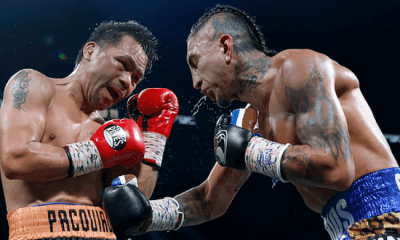
 Featured Articles6 days ago
Featured Articles6 days agoManny Pacquiao and Mario Barrios Fight to a Draw; Fundora stops Tim Tszyu
-

 Featured Articles3 weeks ago
Featured Articles3 weeks agoCatterall vs Eubank Ends Prematurely; Catterall Wins a Technical Decision
-
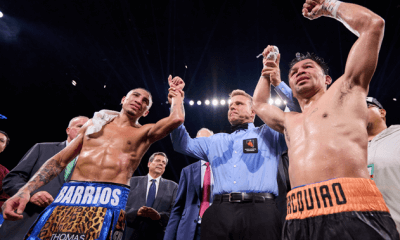
 Featured Articles5 days ago
Featured Articles5 days agoArne’s Almanac: Pacquiao-Barrios Redux
-
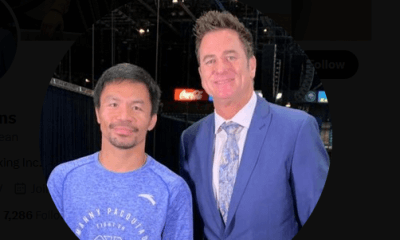
 Featured Articles2 weeks ago
Featured Articles2 weeks agoFrom the Boondocks to the Big Time, The Wild Saga of Manny Pacquiao’s Sidekick Sean Gibbons


